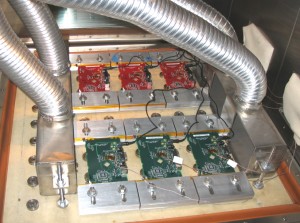Highly Accelerated Life Testing (HALT) is a rigorous reliability test method that is used to expose product weaknesses. The goal of HALT is to proactively find weaknesses and fix them, thereby increasing product reliability. Because of its accelerated nature, HALT is typically faster and less expensive than traditional testing techniques.

HALT can be effectively used multiple times over a product’s life time. During product development, it can find design weakness when changes are much less costly to make. By finding weaknesses and making changes early, HALT can lower product development costs and compress time to market. When HALT is used at the time a product is being introduced into the market, it can expose problems caused by new manufacturing processes. When used after a product has been introduced into the market, HALT can be used to audit product reliability caused by changes in components, manufacturing or suppliers etc. The bottom line is that HALT can reduce product development time and cost, reduce warranty costs, improve customer satisfaction, gain market share, and increase profits.
HALT is not a qualification test, thus there are no predetermined pass/fail criteria. The goal of HALT is to quickly precipitate failures and then to determine their root causes. Once the causes of failure are determined, the failed components are repaired and the stress limits of the testing program are expanded.
Important HALT Definitions
6 Degrees Of Freedom (DOF): Refers to vibration with energy along three orthogonal translations and three rotations simultaneously
Grms: Grms is used to define the overall acceleration level of random vibration. Grms (root-mean-square) is the square root of the area under the PSD curve. More information about random vibration can be found in our blog article Sinusoidal and Random Vibration Testing Primer.
HALT Operational Limit: The stress level prior to where a product does not operate properly, but will return to correct operation if the stress level is reduced. Improper operation can be an out of specification condition. HALT is performed to determine the Operational Limits for low temperature, high temperature, vibration, and combined temperature and vibration.
HALT Destruct Limit: The stress level at which the unit becomes inoperable and will not return to correct operation if the stress level is reduced. HALT Destruct Limits are determined for low temperature, high temperature, vibration, and combined temperature and vibration.
Some Facts and Misconceptions about Highly Accelerated Life Testing
- Producing failures is the goal of HALT testing. The user should not necessarily focus on what level of stress caused the problem, but should focus on improving the weak points in their product.
- By applying an effective HALT procedure, the HALT Operational Limit and HALT Destruct Limit of the products under test can be found.
- The stress levels in HALT are typically far beyond those experienced by the product in its normal operating environment. These higher-than-normal stresses accelerate the time to failure and precipitate defects more rapidly than under actual service conditions.
- The product under test is in operation during HALT and is continuously monitored for operational failures.
- As stress-induced failures occur, the cause shall be determined, and if possible, the component should be repaired so that the test can continue to find other weaknesses.
- Stresses shall be increased until the practical limits of the test parameters have been reached or the fundamental limit of technology has been reached. Examples of practical limits include the melting temperature of solder joints or excessive softening of plastics. The fundamental limit of technology means that the limits of present day knowledge have been reached. An example of this would be that it would cost an unreasonable amount of effort and money to improve existing battery technology.
- One common misconception is that an abundance of failures will occur during every HALT. Numerous failures may occur, but a large quantity of failures is not likely unless the product is very different than any manufactured before. Successful companies produce pretty good products; otherwise they would be out of business. However there may be a weakness or two in a new product that could create early failures resulting in large warranty costs. These weaknesses should be found in a properly run HALT test.
- HALT is a qualitative test with the goal being to expose design weaknesses. It is very difficult to demonstrate a service life or a mean time between failures (MTBF) using HALT. Other reliability methods may be a better fit to predict an MTBF or service life.